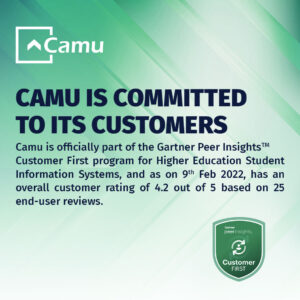
Higher Education Should Meet the Needs of All Stakeholders
At Camu, stakeholder cooperation is a way of life. Yes. By creating an environment of equal opportunity and trust, we create a happy workplace. One that excites, motivates and inspires everyone to work together and do better.
For institutions to excel, we must build a foundation of integrity, trust, respect, passion and collaboration. Aka, stakeholder synergy!
In this blog, we go over 4 main stakeholder groups in higher education. Here’s what you (as an institution) should be thinking about.
- Students – From supporting their unique goals and aspirations to gauging their very specific learning curves, higher education institutions must look to adopt a more student-centric approach to instruction, wherein the responsibility of learning falls upon the student itself. Personalised, engaging, competency-based, cross disciplinary, digitally driven! A one-size-fits-all approach must be substituted for a specialised teaching regime, bearing in mind diverse student profiles – rural student, international student, corporate student. Be it course content, assignment styles, in-class activities, or level of technology integration, it is vital for the learner to remain at the centre of all decision making. And this means knowing where they come from, and where they wish to go. After all, it is not merely about what the teacher covers, but more so, about what the student discovers.
- Parents -It is a fact; Indian parents have tall expectations when it comes to their children’s academic futures. The level of involvement in selecting a university, programme, and even course, is extremely high. Considering the impactful role that they play in a student’s educational graph, it is imperative for higher education institutions to maintain a free-flowing, two-way communication channel with them. Which means updating them about their child’s progress, informing them about day-to-day campus activities, encouraging them to pay visits to teaching faculty, assuaging any/all fears relating to examinations, and more. We are seeing a gradual shift in parent engagement, making this stakeholder group more important than ever.
- Teaching Faculty -Guider, mentor, facilitator, counsellor – a teacher is expected to perform many roles within and outside the classroom. Gone are the days when material is read out from a text book, and a series of questions follow. Today, a teacher wields a variety of resources, tools and teaching styles to make the classroom (physical and virtual) more interesting and engaging. But in order for them to play their part successfully, they too, must feel supported and motivated. Ensuring that they get adequate training within the domains of technical and human skills is a pre-requisite for a higher education institution. Equally, involving them in the processes of curriculum design and development is a necessity. Collaboration between faculty and management ensures long-term goals are met.
- Management – There are many leadership positions and administrative ranks within a higher education institution. Think, Chancellor, Vice Chancellor, Deans/Directors, Chairmen/Head of Departments. Given the mandate of teaching, training and research, many heads need to work together to ensure the smooth functioning of a university. While teaching excellence is the norm, it is also important to understand the impact of policy changes such as new assessment requirements on the balance of the academic model. When actions are taken without input from all of those who may be affected, there are dire consequences. Hence, it will take a collaborative approach between senior management and faculty to find a path that works best for all!
How do you make sure everyone is on the same page? By encouraging open communication. By practicing transparency from the top. By inculcating empathy and understanding. By creating a sense of community.
By leading by example.







